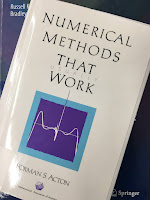 |
| Numerical Methods That Work, by Forman Acton. |
Before he died, Acton donated funds to establish the Forman Acton Foundation. Here is how their website describes his life:
Forman Sinnickson Acton was born in Salem City, and he went on to change the world.Sometimes I will read a passage and say to myself “That’s exactly what students studying from IPMB need to hear.” I feel this way about Acton’s preface to Numerical Methods That Work. Russ and I include many homework problems in IPMB so the student can gain experience with the art of mathematical modeling. Below, in Acton’s words, is why we do that. Just replace phrases like “solving equations numerically” with “building models mathematically” and his words apply equally well to IPMB.
Born on August 10, 1920, he began his education in the Salem City school system before attending private boarding school at Phillips Exeter Academy and college at Princeton University. He graduated with two degrees in engineering toward the end of World War II, during which he served in the Army Corps of Engineers and worked on a team involved in the Manhattan Project.
After his service, he earned his doctorate in mathematics from Carnegie Institute of Technology, helped the Army develop the world’s first anti-aircraft missiles and became a pioneer in the evolving field of computer science.
Acton conducted research and taught at Princeton from 1952 to 1990, during which time he wrote textbooks on mathematics at his cabin on Woodmere Lake in Quinton Township, Salem County. When he turned 80, he joined the Lower Alloways Creek pool to stay in shape, swimming six days a week for 14 years.
He died on February 18, 2014, in Woodstown, New Jersey, but not before he anonymously donated thousands of dollars toward scholarships for Salem City School District students, some of whom were just then graduating from college. Before he passed, he made it clear to friends and confidants that he wanted these students to have access to the incredible educational experiences he enjoyed.
Eight months after his passing, the Forman S. Acton Educational Foundation was officially incorporated to ensure that all of Salem’s youth also have a chance to change the world.
Numerical equation solving is still largely an art, and like most arts it is learned by practice. Principles are there, but even they remain unreal until you actually apply them. To study numerical equation solving by watching someone else do it is rather like studying portrait painting by the same method. It just won’t work. The principle reason lies in the tremendous variety within the subject…
The art of solving problems numerically arises in two places: in choosing the proper method and in circumventing the main road-blocks that always seem to appear. So throughout the book I shall be urging you to go try the problems—mine or yours.
I have tried to make my explanations clear, but sad experience has shown that you will not really understand what I am talking about until you have made some of the same mistakes I have made. I hesitate to close a preface with a ringing exhortation for you to go forth to make fruitful mistakes; somehow it doesn’t seem quite the right note to strike! Yet, the truth it contains is real. Guided, often laborious, experience is the best teacher for an art.








